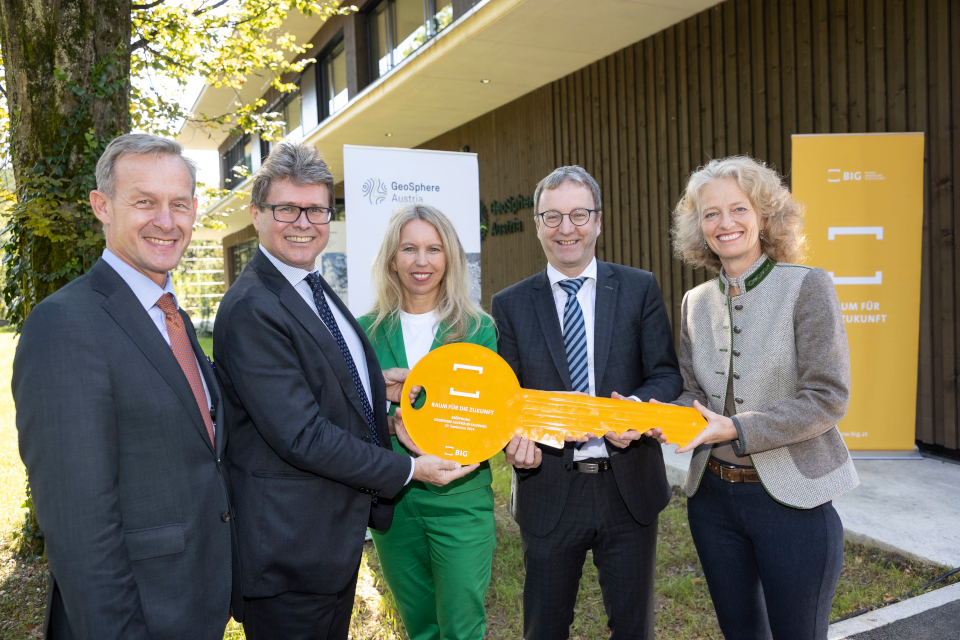Sustainable office building in Salzburg
GeoSphere Austria is getting a sustainable office building in Salzburg. A photovoltaic system on the roof provides electricity. Heating and cooling are provided by an air-to-water heat pump. Accessibility is guaranteed throughout the building.
The Bundesimmobiliengesellschaft (BIG) was commissioned by the Federal Ministry of Education, Science and Research to construct a new office building for GeoSphere Austria in Salzburg-Nonntal. There are 36 workstations for the employees on an area of 773 m². The centrepiece is the new forecasting room, which provides the latest measurement data for science and the public. The Federal Ministry of Education, Science and Research is spending a total of around 3.8 million euros on the new building.
GeoSphere Austria, formerly the Central Institute for Meteorology and Geodynamics (ZAMG), is moving into a two-storey, sustainable office building. All premises are barrier-free. Heating and cooling are provided by an air-to-water heat pump. The building is heated by underfloor heating and cooled by concrete core activation. The main roof is extensively greened and equipped with a photovoltaic system, which ensures a sustainable supply through an additional storage unit. The roof also collects rainwater and feeds it back into the Hellbrunn stream, which is located at the edge of the property.
Together with the BMBWF, the decision was made to construct a new building following various studies. The building was planned by a Salzburg architectural firm: fally plus Partner Architekten.
"We have been implementing high sustainability standards in new buildings for many years. With the GeoSphere Austria office building in Salzburg, we as a federal property company are once again demonstrating how we use renewable energies in the best possible way. Among other things, the photovoltaic system on the roof provides electricity and the heating and cooling is supplied by an air-to-water heat pump. The building is heated by underfloor heating and cooled by concrete core activation. Vertically tensioned steel cables in front of the façade with plants growing up them provide additional shade and reduce overheating in summer," says Gerald Beck, Managing Director of Bundesimmobiliengesellschaft.
Federal Minister Martin Polaschek: "The devastating storms of the last few days have affected many regions and caused great devastation. In order to protect the people in our country, professional and scientifically sound recording, warning and counselling in the area of natural and environmental disasters is more important than ever. As the federal government, we have already taken an important step in the past with the establishment of GeoSphere Austria as the federal government's central competence centre in these areas. With the new regional office in Salzburg, we are strengthening local structures and networking with the authorities in the province of Salzburg."
Sylvia Bauer-Beck, Commercial Director General GeoSphere Austria: "We would like to thank the Ministry of Science and the Bundesimmobiliengesellschaft for the excellent cooperation in realising this new building right on schedule. The new office building provides an optimal working environment for our employees and a very cost-efficient operation by taking into account the latest construction and energy standards."
Andreas Schaffhauser, Scientific Director General GeoSphere Austria: "Our regional office in the city of Salzburg is home to two important departments: the regional office for Salzburg and Upper Austria, which provides daily forecasts and warnings, carries out climatological and environmental meteorological measurements and expert reports and is responsible for the Salzburg avalanche warning service. It is also the headquarters of the Sonnblick team, which looks after one of the world's most important meteorological observatories."
Eva-Maria Kern, 1st Chairwoman of the Board of Trustees of GeoSphere Austria: "An optimal infrastructure of GeoSphere Austria in Salzburg is both a prerequisite for high-quality research work, such as at the Sonnblick Observatory, as well as the basis for close cooperation between the regional office and municipalities, districts and state authorities such as the state warning centre, companies and direct information for the population of Salzburg and Upper Austria."
Translated with DeepL.com (free version)

